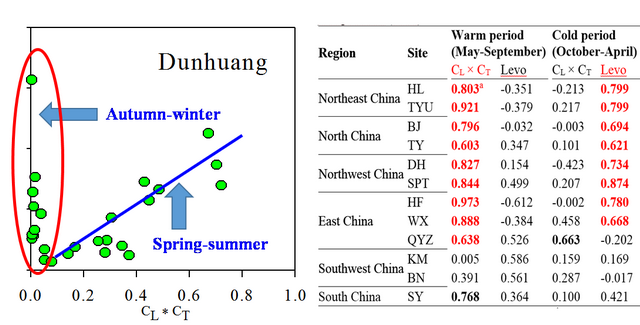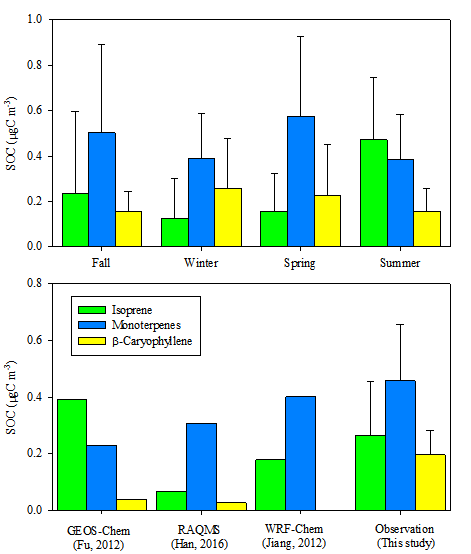Biomass burning (BB) is the most important source of global primary organic aerosols. During the process of BB, large amounts of reactive gases (e.g. terpenoids and NOx) are released into the air and further produce substantial secondary organic aerosols (SOA), which significantly affects global climate change and regional air quality. As the most important SOA precursors on a global scale, terpenoids (isoprene, monoterpenes, and sesquiterpenes) are believed to be mainly emitted from biogenic sources. Almost all models that probe the impact of terpenoids SOA on climate and environment only consider biogenic emissions and use MEGAN (The Model of Emissions of Gases and Aerosols from Nature) to estimate terpenoids emissions.
The scientists at Guangzhou Institute of Geochemistry, Chinese Academy of Sciences (GIGCAS) discover that BB causes unexpected increases of terpenoids SOA in autumn-winter over China. Based on a one-year concurrent observation of terpenoids SOA tracers at 12 sites across 6 regions of China, they find that the spatiotemporal trends of isoprene and monoterpenes SOA in spring-summer are indeed consistent with the prediction of MEGAN parameters, suggesting the majority of biogenic emissions for isoprene and monoterpenes then. However, unexpected increases of terpenoids SOA in autumn-winter cannot be explained by MEGAN parameters. The positive correlations between terpenoids SOA tracers and the BB tracer, levoglucosan in autumn-winter indicate that the unexpected increases of terpenoids SOA are highly associated with the enhancement of BB (Figure 1). Source apportionment results implicate that the composition of terpenoids SOA dramatically changes from a monoterpene majority in fall-spring to an isoprene majority in summer, which cannot fully predicted by current modeling studies (Figure 2). These findings highlight the importance of terpenoids emissions from BB and provide new insight into the sources of terpenoids SOA. These results have been published in Journal of Geophysical Research: Atmospheres and Scientific Reports.
This research is supported by the Strategic Priority Research Program of Chinese Academy of Science (CAS), the National Science Foundation of China, and the Youth Innovation Promotion Association, CAS.

Ding, X.; Zhang, Y.-Q.; He, Q.-F.; Yu, Q.-Q.; Shen, R.-Q.; Zhang, Y.; Zhang, Z.; Lyu, S.-J.; Hu, Q.-H.; Wang, Y.-S.; Li, L.-F.; Song, W.; Wang, X.-M., Spatial and seasonal variations of secondary organic aerosol from terpenoids over China. Journal of Geophysical Research: Atmospheres 2016, 121, 14661–14678. (http://dx.doi.org/10.1002/2016JD025467)

Ding, X.; He, Q.-F.; Shen, R.-Q.; Yu, Q.-Q.; Zhang, Y.-Q.; Xin, J.-Y.; Wen, T.-X.; Wang, X.-M., Spatial and seasonal variations of isoprene secondary organic aerosol in China: Significant impact of biomass burning during winter. Scientific Reports 2016, 6, 10.1038/srep20411. (http://dx.doi.org/10.1038/srep20411)